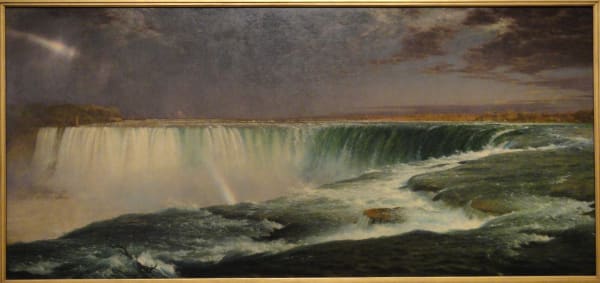Frederic Edwin Church (1826-1900) belonged to the second generation of the Hudson River School, and helped to elevate the status of American landscape artists around the world. In 1857, Church’s 7-foot, 7-inch wide painting, Niagara, was put on display in a dimly lit room of a Manhattan gallery. Tens of thousands of people paid 25 cents to view the work. It traveled around the world, shown at the Exposition Universelle in Paris and now resides in the National Gallery of Art in Washington, D.C..
Landscape painters recorded, not only the scope of the landscape, but also the details of flora and fauna of each area.
Thomas Cole, seen as the founder of the Hudson River School, taught and mentored Church. Cole witnessed the effects of industrialization on the landscape; “Nothing is more disagreeable to me than the sight of lands that are just clearing with their prostrate trees, black stumps burned and deformed.” Cole wrote, “All the narrative beauty of the forest taken away by the improving man. And alas, he replaces it with none of the beauties of Art.”
During the nineteenth century, before the mass-marketing of cameras, artists were invited on scientific expeditions to record the landscapes being studied.
Recently, a group of scientists studying forestry ecosystems, the environment, natural resources and their impact on the environment, published a study that looks at the advantages and drawbacks of studying nineteenth century landscapes for ecological research.
Much of the work of the Hudson River painters was very complex, very detailed, as noted in a 2021 Forestry Report: “Whether the structure is a woodpecker cavity or a complex of climbing vines, these features are the very details with which artists such as Church, or Durand filled their canvases. Not only do they provide optical foci, but they also illustrate the specific microclimatic and substrate conditions that specialized organisms need in order to shelter, forage, or breed. Because microhabitat features provide an essential habitat component to a variety of organisms, they can also demonstrate potential for species presence in a forest.”
Artist’s preliminary sketches may be the most true rendering of a particular landscape. Church traveled extensively, to Europe and the Middle East, and often combined features from different locations in a single work, making it difficult for researchers to study the paintings for the accuracy of the ecosystem.
Whether scientifically accurate or not, the works of Frederic Edward Church are beautiful, full of wonder and give the viewer a sense of what the world looked like to a greatly talented nineteenth century artist.
References:
Dana R. Warren, Harper M. Loeb, Peter Betjemann, Isabel A. Munck, William S. Keeton, David C. Shaw, Eleanor J. Harvey. An interdisciplinary framework for evaluating 19th century landscape paintings for ecological research. Ecosphere. Volume 14. Issue 9. September 2023.
Asbeck, T., J. Grossmann, Y. Paillet, N. Winiger, and J. Bauhus. The Use of Tree-Related Microhabitats as Forest Biodiversity Indicators and to Guide Integrated Forest Management. Current Forestry Reports 7: 59–68. 2021.
Elaine Velie. Hudson River Paintings Could Shed Light on Long-Gone Forests. Hyperallergic. October 11, 2023.


